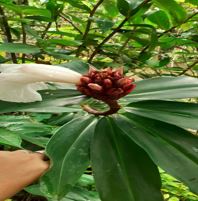Literary Review on Kebuka [Costus speciosus (J.Koenig) Sm.]
Keywords:
Ayurveda, Kebuka, Costus speciosus, Spiral flag, ethnomedicineAbstract
Introduction: The plant Kebuka a is a perennial herb used in Indian systems of medicine and is widely used in folklore medical practice throughout the world. Kebuka (Costus speciosus (J.König) Sm.) belonging to the family Costaceae, is one among the plants described under Shaka Varga (Group of vegetables), a sub-group of Ahara varga (Group of eatables) as mentioned in classical treatises of Ayurveda. Aim: To obtain a comprehensive review on Kebuka (as a medicinal plant) from Ayurvedic scriptures and Ethnomedicinal use of the plant. Results: Various names have been attributed to it in the classics. The single use of the drug and its use in compound formulations is mentioned in Brhattrayi and Nighantus of Ayurveda. The drug shows wide application under ethnomedicinal practices. Conclusion: Through the review, the medicinal aspects of the drug were understood as mentioned in Ayurveda classics and from ethnomedicinal uses. Since the drug is widely distributed and easily available in the most parts of Indian subcontinent, further pre-clinical and clinical research on the drug is required to establish the therapeutic efficiency and it’s mechanism of action in various disorders.
Downloads
References
Tag H, Das A, Loyi H. Anti-inflammatory plants used by the Khamti trive of Lohit district in eastern Arunachal Pradesh, India. Natural Product Radiance. 2007, 6(4), 334-340.
Dubey N, Kumar R, & Tripathi P. Global promotion of herbal medicine: India's opportunity. Current Science. 2004,86(1), 37-41.
Chunekar KC. Bhavaprakasha Nighantu of Bhava Mishra. Varanasi: Chaukhambha Bharti Academy. Chapter Shaka Varga: Verse 110; 2015, p687.
Sharma PV. Kaiyadeva Nighantu, Aushadhi Varga: Verse 1607. Varanasi: Chaukhambha Orientalia. 2019, p643.
Acharya YT, Nibandha sangraha of Dalhana on Sushruta Samhita of Sushruta, Uttaratantra, Chapter 54, Krimiroga Pratishedha, Verse 25. Varanasi: Chaukhambha Sanskrit Sansthana. 2013, p:233.
CCRAS. Database on Medicinal Plants used in Ayurveda. Vol 7, New Delhi. 2005, p:207.
ICMR, Quality Standards of Indian Medicinal Plants. Vol 7, New Delhi. 2008, p:47.
Kirtikar KR and Basu BD. Indian Medicinal Plants. Allahabad, Lalit Mohan Basu. Vol 4, 2nd ed, 1995, p:2440.
CCRAS. Pharmacognosy of Indigenous Drugs. Vol 1, New Delhi. 2005, p:565,573.
Acharya YT. Charaka Samhita by Agnivesha, Sutra Sthana, Chapter 27 Annapana vidhi, Verse 96. New Delhi: Chaukhambha Publications. 2016, p:159.
Acharya YT. Sushruta Samhita of Sushruta, Sutra Sthana, Chapter 46 Annapana vidhi, Verse 263. Varanasi: Chaukhambha Sanskrit Sansthana. 2013, p:233.
Ashtavaidyan Vaidyamadhoom Cheriya. Ashtanga Hrdaya Samhita with Shashilekha commentary of Indu, Chapter 6 Annaswarupa Vijnaniya, Verse 79. Varanasi: Chowkhambha Krishnadas Academy. 2007, p:40.
Jyotir Mitra. Ashtanga Samgraha of Vrddha Vagbhatta with Shashilekha Sanskrit commentary, Sthana Sutra, Chapter 7, Annaswarupa Vijnaniya, Verse 105. Varanasi: Chowkhambha Sanskrit Series Office. 2012, p58.
Sharma PV. Dravyaguna Vijnana. Varanasi: Chaukhambha Bharati Academy. Vol 2, 2018, p:605.
AYUSH. Ayurvedic Pharmacopoeia of India. Vol 5, 1st ed; New Delhi. 2006, p:74.
e-Nighantu, Raj Vallabha Nighantu, https://niimh.nic.in/ebooks/e-Nighantu/rajavallabhanighantu/?mod=read
Sharma PV. Classical Uses of Medicinal Plants. Varanasi: Chaukhambha Visvabharati. 2018, p:113.
CSIR. The Wealth of India. First Supplement Series, Vol 2, New Delhi. 2001, p:210.
Nadkarni KM. Indian Materia Medica. Mumbai: Popular Prakashan Pvt Ltd. Vol 1, 3rd ed, 2019, p:385.
ICMR. Reviews on India Medicinal Plants. Vol 7, New Delhi. 2008, p:68.
Chunekar KC. Bhavaprakasha Nighantu of Bhava Mishra; Chapter Haritakyadi Varga. Varanasi: Chaukhambha Bharti Academy. 2015, p:9.
Ika Puspita Sari, Arief Nurrochmad. Sub-acute toxicity study of an ethanolic extract of pacing (Costus speciosus) in male mice. Int J Pharm Pharm Sci. 2016;8(12):97-10.














